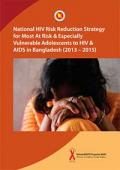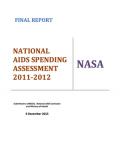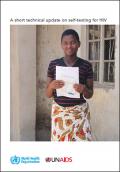What's New
Displaying results 3431 - 3440 of 4914

Resource | Publications,
As this latest Global report makes clear, today we have the tools we need to lay the groundwork to end the AIDS epidemic.
This report highlights continued progress towards the global vision of zero new HIV infections, zero discrimination and zero AIDS-related deaths. The annual number of new HIV infections continues to decline, with especially sharp reductions in the number of children newly infected with HIV. More people than ever are now receiving life-saving antiretroviral therapy, contributing to steady declines in the number of AIDS-related deaths and further buttressing efforts to prevent new infections.
These achievements reflect the synergistic efforts of diverse stakeholders – the leadership and commitment of national governments, the solidarity of the international community, innovation by programme implementers, the historic advances achieved by the scientific research community and the passionate engagement of civil society, most notably people living with HIV themselves.

Resource | Publications,
The time for a unified answer to the challenges of today and tomorrow is now: new Global Development Goals will be decided on by next year; the concept of universal health coverage is gaining global traction; and research-based innovations continue to offer major advances in therapy.
To bring all stakeholders together to translate medical innovations into global health frameworks on an affordable basis, new platforms for meetings and dialog are needed. The World Health Summit provides such a platform for delegates from different pillars of society to help shape tomorrow’s health care agenda.
In its fifth year, the World Health Summit continues to connect present and future leaders of global health, active in academia, politics, the private sector, and civil society. It is this spirit that permeates the WHS Yearbook by providing direction for future advances to improve health worldwide, and by offering information on the issues and initiatives raised at the World Health Summit 2013.

Resource | Reviews and Snapshots,
Snapshot of HIV and AIDS in Malaysia 2013 captures the latest national HIV and AIDS surveillance data by the Ministry of Health.

Resource | Guidelines,
The guidelines are aimed at health-care providers because they are in a unique position to address the health and psychosocial needs of women who have experienced violence. Health professionals can provide assistance by facilitating disclosure; offering support and referral; providing the appropriate medical services and follow-up care; or gathering forensic evidence, particularly in cases of sexual violence.

Resource | Publications,
This book explores new concepts and identifies critical themes in migration studies in ASEAN, with a focus on selected emerging trends, namely: various forms and degrees of environmental change and how these changes transform migration; labour, human trafficking and migration; migrant children; and gender. It presents selected papers from two conferences at Chulalongkorn University hosted by the Asian Research Center for Migration (ARCM) and its partners, held to mark International Migrants Day on 18 December in 2011 and 2012.
The conferences emphasized the ongoing importance of recognizing and meeting the challenges of migration in both its long-standing and new forms, and facilitated discussion among policymakers, planners and representatives from national ministries of the Royal Thai Government and across ASEAN, international and national organizations, and nongovernmental organization (NGOs) to explore the range of issues associated with migration conceptually and from experiences on the ground.

Resource | Publications,
Bangladesh continues to have a low but concentrated AIDS epidemic with national HIV prevalence less than 0.1%. While the level of HIV infection remains generally low in the country, there are considerable vulnerabilities and risk that put children and adolescent at risk of infection. This has become important as the country has a large cohort of children and adolescent population under 18 years of age estimated at 45% of the total population.
The National HIV Risk Reduction Strategy for Most At Risk & Especially Vulnerable Adolescents to HIV & AIDS in Bangladesh (2013 – 2015) was informed by the result of the Mapping and Size Estimation of Most At Risk Adolescents in Bangladesh conducted in 2011 with support from UNICEF. This strategy emphasizes key actions to improve legislation, policy and programmes to reduce risk and protect MARA/EVA in Bangladesh from HIV and AIDS.

Resource | Presentations,
Behavioral sentinel surveillance (BSS) has been conducted by NCHADS to document behavior changes among sentinel groups since 1997. The objectives of the BSS 2013 are:
- To document HIV related risk behaviors among selected sentinel groups
- To tracks trends in risk behaviors among EW and MSM groups
- To explore common practices toward the use of VCT, STI clinics sexual health and other relevant services
- To investigate the attitude and practice on adherence and towards positive prevention among PLHIV
- To evaluate coverage and the outcomes of interventions targeting selected sentinel groups

Resource | Publications,
HIV and AIDS are among health issues prioritized in the Millenium Development Goals (MDGs) and require considerable attention from various stakeholders. The Government of Indonesia, along with international partners has been working hard in suppressing the spread of AIDS in the country through various programs. However, more challenges remain, and despite considerable amount of money spent in resources to combat HIV and AIDS in Indonesia, the rate of new cases of HIV continue to persist.
To analyze spending for HIV and AIDS in Indonesia, data was collected from various sources: public, international partners, private.

Resource | Tools,
This technical update was prepared in November 2013 in collaboration with key experts, the World Health Organization (WHO) and the Joint United Nations Programme on HIV/AIDS (UNAIDS). Its primary objective is to synthesize experiences, research and policies on HIV self‑testing to inform stakeholders who are considering or already implementing HIV self‑testing.

Resource | Publications,
For Thailand 2012 MICS, the National Statistical Office's aims were to obtain updated information on the situation of children and women, including various key indicators that allow countries to monitor progress towards the Millennium Development Goals (MDGs), A World Fit for Children (WFFC) and other internationally agreed upon commitments. The data/information obtained from Thailand 2012 MICS can be used by government organizations in their evidence-based plans and policies regarding children and women.





